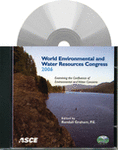Application of Multi-Criteria Tool in MIKE SHE Model Development and Testing
Publication: World Environmental and Water Resource Congress 2006: Examining the Confluence of Environmental and Water Concerns
Abstract
The water resources in the northern part of Belgium have been profoundly influenced by anthropogenic activities. Physical deterioration of rivers and their floodplains is common. In general, hydrometeorological disasters have grown to be the most significant natural disaster in terms of frequency, but also in terms of costs to human life and property damage. River valley rewetting is believed to influence the ecology positively, especially during the dry summer months. However, its hydrological influence on the catchment over the annual cycle remains unclear, especially with regard to the winter months. Thus, this research undertook to build an integrated catchment model for a part of northern Belgium in order to study the hydrological influence of rewetting. The paper details the development and testing processes of the model. It highlights the design of a multi-criteria protocol that was used to develop and test the model, the process of determining recession constants corresponding to base flow, interflow, and overland flow components, and the paradox of homoscedascity. It describes WETSPRO, which is a tool for time series analysis which incorporates a recursive digital filter for exponential recessions to split total rainfall-runoff discharges into three components namely, base flow, interflow, and overland flow. The paper presents the results of an implementation of WETSPRO in multi-criteria model development and testing, during which the following plots were utilized: Modeled vs. observed discharge maxima during (nearly independent) quick-flow hydrograph periods; Modeled vs. observed discharge minima during (nearly independent) base-flow or slow-flow hydrograph periods; Cumulative flow volumes; High flow extreme value statistics; Low flow extreme value statistics; and Discharge time series, with and without log-scale for the discharge. Using the multi-criteria protocol, a hydrological model was built. The flow recession constants were determined as approx. 12 hours for quick flow, and 2 months for slow flow. This model is being used to study the effects of anthropogenic changes on the catchment hydrology.
Get full access to this chapter
View all available purchase options and get full access to this chapter.
Information & Authors
Information
Published In
Copyright
© 2006 American Society of Civil Engineers.
History
Published online: Apr 26, 2012
ASCE Technical Topics:
- Base flow
- Bodies of water (by type)
- Business management
- Catchments
- Decision making
- Decision support systems
- Engineering fundamentals
- Flow (fluid dynamics)
- Fluid dynamics
- Fluid mechanics
- Hydrologic engineering
- Hydrologic models
- Models (by type)
- Numerical models
- Overland flow
- Practice and Profession
- River engineering
- Rivers and streams
- Water and water resources
- Water management
- Water policy
- Water resources
Authors
Metrics & Citations
Metrics
Citations
Download citation
If you have the appropriate software installed, you can download article citation data to the citation manager of your choice. Simply select your manager software from the list below and click Download.
